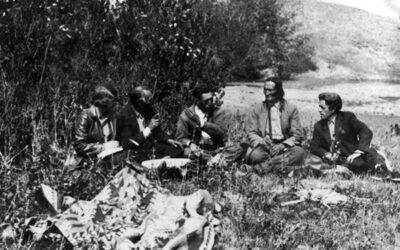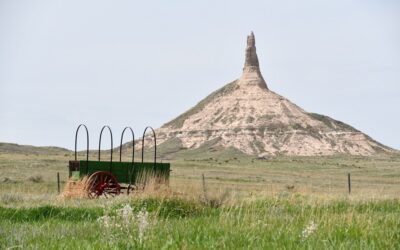HISTORY NEBRASKA MANUSCRIPT FINDING AID
RG0971.AM: Gerdes-Whitmore Families
Papers: 1876-1990
Litchfield, Custer County; and Beatrice, Gage County, Nebraska: Teachers, ranchers and farmers
Size: 0.25 cu.ft.; 1 box
BIOGRAPHICAL NOTE
Florence Whitmore Gerdes Gallop (1902-1990) was born near Emerald, Nebraska, and grew up near Litchfield in Custer Country. Her parents were Herbert Williams Whitmore, born in Ohio in 1867, and Jessie Pauline Mott Whitmore. Her uncle, Judge Howard James Whitmore (1857-1942) was born in Iowa; he was a U.S. commissioner in Lincoln for 29 years.
Florence was the fourth of five children. Alice Maria (born 1895) became a teacher; Herbert Knisely (born 1897), Wilbur Elgin (born 1899) and Donald Dewitt (born 1906) all became Wyoming ranchers.
Florence was first hired to teach at the Good Hope School, two and a half miles from her western Nebraska home, in 1919 before she had graduated from high school; she went on to finish high school and attend University of Nebraska summer sessions. In 1922-1923 she taught a class of 60 fifth-graders in Alamosa, Colorado; she resigned to marry Bert Gerdes. She later earned an M.Ed. degree from the University of Montana (1952).
Florence and Bert farmed near Beatrice. They had five children: Loren, Carol, Alea, Keith, and Stephen. The family lost its land during the Depression. Bert took his own life in 1936. Florence and the children then moved to Wyoming; in her final years Florence lived in Oregon.. At the time of her death, a cousin wrote that “Florence recognized her potential and she used it all,” well-deserved praise for a woman who, left without financial support, managed to discover opportunities for herself and her children, all college graduates: two lawyers, an engineer and a teacher.
SCOPE AND CONTENT NOTE
The Gerdes-Whitmore Families collection contains two series: 1) Memoirs; and 2) Correspondence.
The original Memoirs and letters are not in the History Nebraska collections; only photocopies are available.
Series 1 consists of two Subseries: Florence’s memoirs (Subseries 1), written intermittently during the 1980s; and the reminiscences (Subseries 2) of her grandmother, Elizabeth Catherine Gilbert Whitmore (Mrs. Joseph Knisely Whitmore).
Florence describes her childhood on the prairie and an education that required her to board with family members living near schools. She provides details about her teaching career in rural and later town schools and the challenges of raising her children after the death of their father. She focuses on the details of daily life: the introduction of jell-o; the flu epidemic; the muddy, unsurfaced roads; the rundown farm houses whose bedbugs had to be treated with gasoline; the social life provided by the Grange, Chautauqua summer activities, and a literary club; rural electrification. Her memoirs break off in the 1960s with her retirement.
Florence’s paternal grandmother Elizabeth Whitmore, born in Gettysburg, Pennsylvania in 1831, had moved to Emerald, Nebraska in 1881; the family believed that her undated recollections had been written around 1920. She describes her parents’ siblings and her own as well as the series of moves that brought her to settle in Nebraska.
Series 2 holds letters from many family members; most describe life on ranches. Some reveal a keen interest in the progressive agricultural practices taught at the university and made known throughout the state by Extension agents. A particularly fascinating group of letters tells of the lives of Florence and her siblings when they were students at Agriculture High, a special University of Nebraska school in Lincoln for children from farming and ranching families. Although they were preoccupied with managing on a very tight budget and taking care of themselves in the city, the children requested news of the livestock and crops at home in every letter they wrote. Poignant letters written after their deaths describe Bert and Florence Gerdes for their children.
INVENTORY
Series 1 – Memoirs
Subseries 1: Florence Whitmore Gerdes Gallop’s memoirs, 1981-ca. 1990
Box 1
Folder
- FWGG memoirs, pp. 1-66
- FWGG memoirs, pp. 67-133
- FWGG memoirs, pp. 134-166
Subseries 2: Elizabeth Catherine Gilbert Whitmore’s memoirs, undated (1920?)
- ECGW memoirs
Series 2 – Correspondence
- Letters, 1876-1894
- Letters, 1894-1923
- Letters, 1923-1934
- Letters, 1934-1954
- Letters, 1990 and undated
Subject headings:
Agriculture — Nebraska
Cody (Wyoming) — History
Custer County (Nebraska) — History
Depressions — 1929
Education — Nebraska
Education — Wyoming
Gallop, Florence (Whitmore) Gerdes, 1902-1990
Gettysburg (Virginia) — History
Whitmore Family
Whitmore, Elizabeth Catherine (Gilbert), 1831-1925
Whitmore, Howard James, 1857-1942
Widows
Women — Nebraska — Custer County
Women — Wyoming
Revised TMM 04-25-2007



